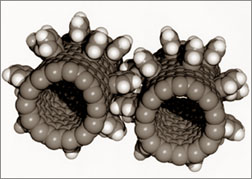|
observer |
|
|
|
|
|
OTHER LINKS |

|

|

|
Towards a future with 'Nano'Can you believe making different types of drinks from one colourless liquid by merely adjusting your microwave owen? Yes it is not a fiction any more.... such drinks will be available in the market in the near future for consumption as new inventions of 'Nanotechnology'.
This can be considered as the next greatest industrial revolution second to none. Nanoscale is very important and unique as nothing solid can be made any smaller and exhibiting of different physical properties as described below. Nanotechnology, will be able to lead many major market segments such as cosmetics, fertilizers, seeds, pesticides, farm inputs, automobile, IT, sports and importantly food items. Several Nano food products can be seen in shelves of bigger super market chains in Europe and US. Multinational food companies such as Nestle, Unilever, and Kraft are already into Nano - redesigned food business. Kraft has taken the lead by establishing first nanotech laboratory in 1999. Around 60 countries have established national research institutes and programs including EU, US, Japan, and China. Amazingly the US government alone has spent more than $5 billion in R&D programs of nanotechnology which is recorded as the biggest funding since Apollo moon shot. NanotechnologyWhat is Nanotechnology? Theoretically the term of Nano derived from Greek for 'dwarf' refers to the scale of Nanometre (nm). Roughly a unit of nano is 80,000 times smaller than the width of a human hair. Today nanotechnologists have been able to peer into molecules to re-engineer the atoms into new molecular structures giving room to introduce unimaginable fancy foods. At this invisible scale substances behave in an unusual manner than their conventional characteristics upon their size and shape. For example, nanosised particle of gold can be viewed in bright red colour while displaying very strong reactivity though gold is usually an inert substance. Scientists have made use of this latent characteristic of some substances to manufacture various products. In line with that, some cosmetic companies include nanoparticals of zinc oxides and titanium oxides into sunscreens as these being transparent in nano form and possesses inheritance reflecting ability of ultraviolet light. Using a similar technique some medical equipment producing companies manufacture bandages adding silver nanoparticals which contain antibacterial properties whereas silver doesn't exhibit such characteristics in general form. Meanwhile, Nanotechnology successfully applied to help remove air pollutant in automobile industry and manufactured special coating for sports clothes and gears which has given rise to improve athlete's performances. However, the ideology among scientists is that they have only scratched the surface of the potential of Nanotechnology. AssemblingScientists adopt two major assembling practices in nanotechnology. These methods are two different and could be applied on different cases. "Top down process" Scientists strive to create smaller structures from bulk material. This process is called top down process and today it is commonly used to create computer chips the tiny memory and logic units. Anyway this process is not popular among inventors as it is too costly and technically impossible. Because assembling computer chips or their material at the nano scale is not possible. The reason for that is the difficulty in assembling tools at nano scale and making precise tools to match with nano scale. "Bottom up process" This process involves the manipulation of atoms and molecules to form nanostructure. This method gives a right solution for previous top down process though challengeable. Here nanostructures are assembled atom by atom and molecules by molecules from atomic level up. As this process is identical to nature, scientists do not find difficulties in assembling, unlike the 'top down process.' Nanotechnology subdivided in different directions especially on most relevant subjects to Human being. It involves with altering living tissues, viruses, proteins and bacteria at the nano scale. This allows companies and individuals to claim patents for their intellectual properties of none elements, molecules and composition of the matter extending co-operate ownership of life to the preliminary elements of nature. Recently, Thailand researchers at Chiang Mai University were able to drill a nanosize hole in a rice cell through which they have introduced extra nitrogen atoms to rearrange the DNA of the rice. They have successfully altered the conventional colour of rice from purple to green. Similarly a prominent Synthetic biologist J. Craig Venter into new experiments to identify the possibility of designing an artificial bacterium able to photosynthesize more efficiently than existing plants do. EngineeringFor example, Nanotechnology based flexible thing-film computers housed in plastic products wrapping enable all at once check out. Thereby customers may simply move the carts through detection gateway for their billing process. Thereby cashiers, wrappers, helpers will lose their jobs. However, doors are opening for new types of career opportunities generated by Nanotechnology. Unfortunately only few toxicological researches done on engineered nanopartcals but it confirms that nanoparticals are capable of being highly toxic due to their smaller size. When a substance categorised under nanoscale such particles spread over larger surface area which creates more chemically activate situation. A study in 2005 shows that bucky balls (A type of carbon nano particle) clump together in water to form soluble nanoparticals and that even in very low concentrations they could harm soil bacteria, leaving a question for scientists to probe into how these carbon molecules interacts with natural ecosystem. Importantly, as we discussed earlier a substance that inert at marco scale or even micro scale can gain hazardous characteristics at the nano scale. Another concern is that the increased reactivity of nano particles could harm living tissues causing inflammation, tissue damages or growth of tumours. |











